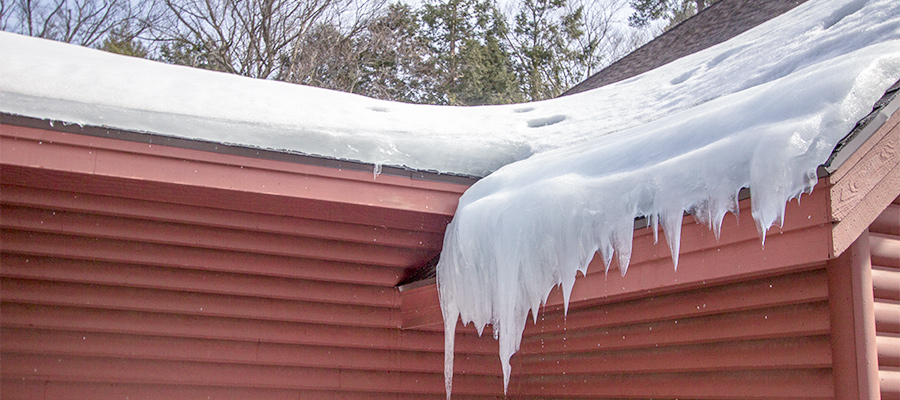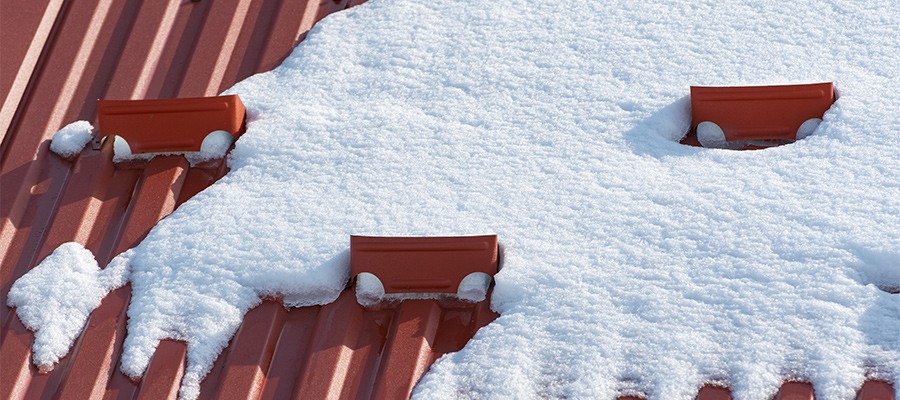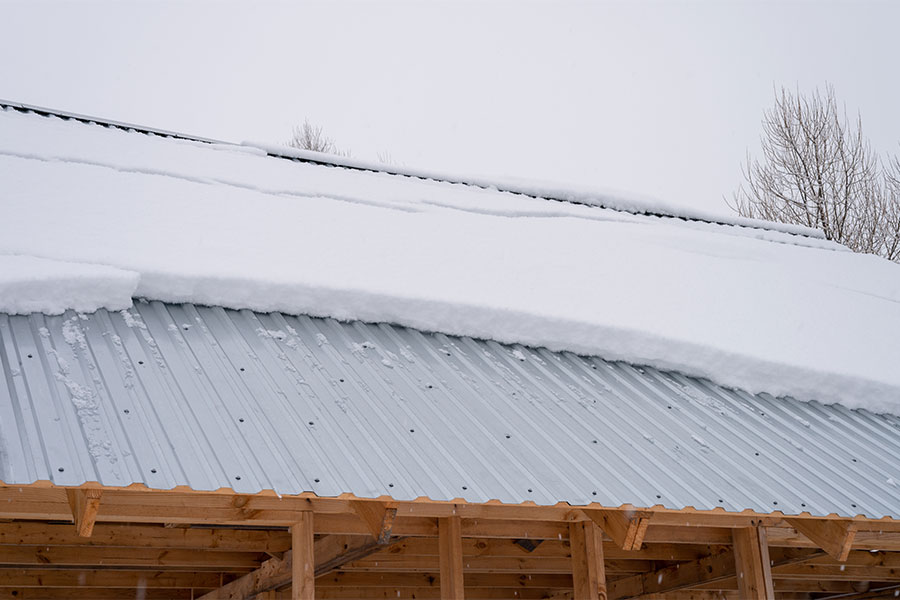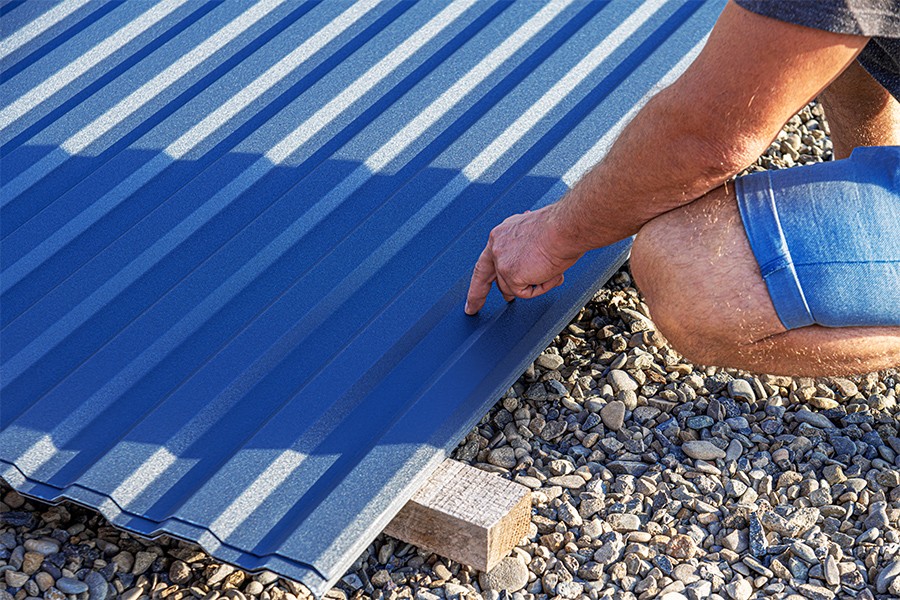We’re no stranger to cold weather in Montana. Icy gales, heavy snowfall, and double negative degree weather are all part of the winter experience.
However, ice dams on your metal roof are a chilly occurrence you shouldn’t have to face. Ice buildup on your roof can lead to costly long-term damage and diminish your metal roof’s value. At Great Northern Metal Company, we’ve seen the toll ice dams can take on a metal roof, so we want to arm you with the knowledge for how to stop ice dams in their tracks.
If you’re in Montana and concerned about an ice dam forming on your roof or want to ice dam-proof future metal roofing projects, you’re in the right place. Keep reading for our experts’ solutions.
What is an Ice Dam?
An ice dam is a ridge of built up ice that forms at the edge of a metal roof, preventing melting snow from draining off. They usually form after a bout of heavy snowfall or extreme cold and can be found on the lower portions of roofs or gutters.
Ice dams form through repeated cycles of freezing and thawing. The snow collects on the roof, melts, then collects on a lower portion of a roof where it is colder or not well insulated. There, the ice steadily builds up and creates a heavy ice barrier. This phenomenon is very common in cold climates like Montana’s, particularly on sloped metal roofs or the North and East angles of roofs where sunlight is sparse.
What Causes Ice Dams?
The main cause of ice dams is the uneven heating of your roof. This is typically due to poor attic insulation and ventilation. When the upper areas of your roof remain above freezing, snow melts and flows down to the colder eaves, where it refreezes and forms an ice dam. Other contributing factors include:
- Heat loss from the house
- Snow accumulation on the roof
- Complicated designs on the North and East aspects of the roof
- Outside temperatures that consistently stay below freezing
What Damage can Ice Dams Cause?
If left to build up, the fallout of ice dams can be extensive and expensive. When ice dams build up, the standing water on your roof can leak into your building. These leaks can ruin the insulation in your attic, leading to increased energy costs, mold, and mildew growth. Also, water infiltrating the building’s structure can stain and damage ceilings and walls, peel paint, and warp floors.
On the outside of your building, ice dams can wreck your roof’s metal panels. Ice expands when it forms, which can damage the seams of panels and pull trim apart. This can lead to you needing to replace metal panels, which can be both time consuming and expensive. Ice dams often form in gutters and, if severe enough, can cause your entire gutter to fall from the weight of buildup. Also, damage to your gutter can lead to fascia damage, such as stripping the paint and even tearing it down.
In short, it’s better to prevent ice dams now rather than to have a costly headache in the long run.
Ice Dam Prevention Tips
To stay on top of ice dams, you must consider four factors: design, heat loss, roof ventilation, and maintenance. By taking into account each of these aspects, you can keep your roofs free from ice dams and long-term damage. Here are some actionable tips to help you protect your metal roof:
Design
- Consider the Slope of Your Roof: If you are designing or building in a cold climate, make sure your roof’s slope accounts for the risk of ice damming. Metal roofs with steeper slopes drain snow, ice, and water more effectively. Typically, a slope over 3/12 is best for shedding water.
- Install Oversized Gutters: Installing larger gutters can help reduce the risk of ice damming by accommodating a greater flow of melting snow and water. This ensures the water drains freely and prevents ice buildup. However, if you upgrade to bigger gutters, you may need to account for this change in the rest of your roofing design. Bigger gutters may necessitate larger downspouts and stronger supports to manage the increased load and maintain system integrity.
Heat Loss
- Enhance Attic Insulation: Upgrading your attic’s insulation is a fundamental step in preventing ice dams. Effective insulation helps maintain a uniform temperature across the roof, preventing the snow on the warmer upper areas of the roof from melting and then refreezing at the colder eaves. This not only reduces the risk of ice dams but also improves the overall energy efficiency of your building.
- Install Heated Cables: Heated cables installed along the edges of your roof can be an effective proactive measure. These cables heat up the areas where ice dams typically form, ensuring that any water from melted snow flows off the roof instead of refreezing. It’s important to install these cables before the winter season begins and to ensure they are correctly positioned and secured to be most effective.
- Seal Air Leaks: Sealing air leaks from the living spaces below the attic is another critical measure. Warm air that escapes into the attic can cause uneven temperatures on the roof, facilitating ice dam formation. Use caulking or foam insulation to seal around light fixtures, pipes, chimney passes, and other potential leak sites in the attic.
Ventilation
- Improve Ventilation: Proper attic ventilation is critical in maintaining a cool roof temperature by allowing a natural flow of cold air. Soffit and ridge vents should be installed to create a balance that pushes warm air out while drawing cold air in. This balance is crucial for minimizing the amount of snow melting on the roof due to heat from the attic.
Maintenance
- Clear Snow from the Roof: Regularly removing snow from your roof dramatically lowers the risk of ice dam formation. Use a roof rake after heavy snowfall to clear the first three to four feet of the roof edge where ice dams typically form. This prevention method is especially crucial during deep freeze cycles. If you’re unable to safely remove the snow yourself, consider hiring professionals.
- Regular Maintenance and Inspections: Schedule annual or bi-annual inspections with a professional to ensure your roof and attic insulation are in good condition. These inspections can help catch potential problems like deteriorating insulation or blocked ventilation before they lead to ice dam formation. Regular maintenance checks also help extend the life of your roof by ensuring that minor issues are addressed promptly.
Cold Weather Resources
If you’re braving the harsh Montana winters, maintaining your metal roof is crucial. Dive into our range of articles tailored to help you keep your roof in top condition:
- Everything You Need to Know About Snow Breaks and Metal Roofs
- Metal Roof and Snow: Are Metal Roofs Better for Snow and Winter?
- Are Metal Roofs Good for Snow & More Cold Weather FAQs
Get Expert Advice from Great Northern Metal Company
Want to ensure your metal roof stands up to Montana’s harsh winters? At Great Northern Metal Company, we don’t just supply high-quality metal roofing and siding. We provide valuable insights and expert advice on the best practices for metal roofing, including preventing ice dams.
Contact us today to learn how our products can enhance your roofing projects and help you manage Montana’s winter challenges. Let’s work together to keep your roof safe throughout the snowy season.




